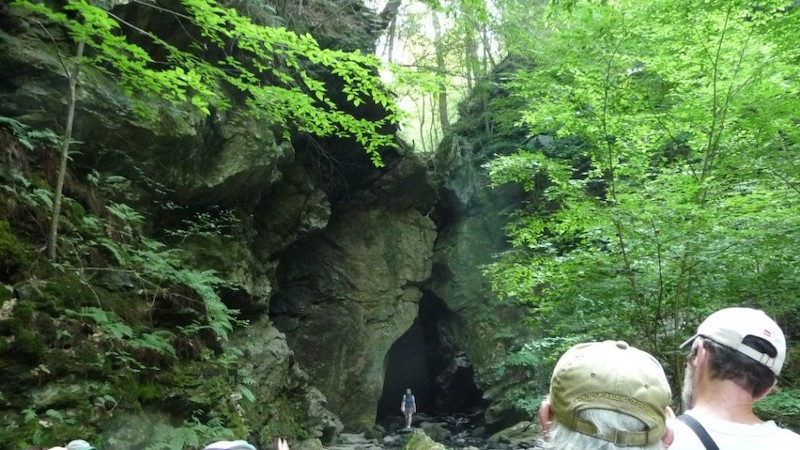A Partnership to Acquire Land for the Public
A site of impressive ecological, geological, and historical importance, the Dover Stone Church is a well-known landmark in Dutchess County and surrounding areas. When the DLC and the Town of Dover were notified that the property, consisting of 58 acres within walking distance of the Village of Dover Plains, was going to be sold, the DLC and the Town began laying plans to protect it. With unique natural, cultural, and historic resources that could benefit many, this was an opportunity to preseve land for public use.The Dover Stone Church is a geological formation of metamorphic rock located on the Stone Church Brook that has formed a natural cavern with an interior waterfall. The “church” itself is formed by a fissure in rock through which the Stone Church Brook flows, forming a number of ledges and beautiful waterfalls descending into a pool below. The outlet of the stream is through a stately arch, which forms the cathedral-like entrance to the cave and is also the basis for the name, Stone Church. "Stone Church" is actually a geological term that refers to a shallow cave created by a stream that drops into a fissure in bedrock and erodes a wide door-like opening. This unique landform has been attracting the attention of artists and curiosity seekers from across the region since the 1800’s.
The Dover Stone Church has wonderful historical significance. Its first known reference dates back to the 1600’s, when legend states that Pequot Indian Chief Sassacus and his warriors hid in the cave to escape capture by the English Army. The popularity of Stone Church dates back to the 1830’s and lasted well into the 1900’s when thousands of visitors each year would travel from New York City to see this natural phenomenon, with train service via the NY & Harlem Railroad in 1848.
The Dover Stone Church was also a Master Drawing of the Hudson River School of Art, depicted in 1847 by Asher B. Durand, and was a subject of a book entitled The Dover Stone Church by Benson Lossing, a Dutchess County historian. Before Franklin D. Roosevelt, became President in 1933, he Chaired the Taconic State Park Commission, and noted at a meeting held on June 28, 1925 that the Dover Stone Church fit in with their goals to preserve natural and historical monuments and that members of the Commission were urged to visit Dover Stone Church.
The Dover Stone Church Purchased!
Through much dedication, hard work, and collective energy, the DLC, a local citizens group (the Friends of Dover Stone Church), the Town of Dover, and Dutchess County worked together to raise the money to buy and protect the Dover Stone Church. With the DLC’s help, the property was purchased by the Town, and the DLC purchased a conservation easement on the land, ensuring its forever protection.Growing the Preserve - Additional Land Added!
In order to further protect the property, the DLC helped to secure an additional 62-acre land donation that became part of the preserve, plus 24.5-acres of viewshed protection through a conservation easement. In October of 2010, the DLC, the Friends of Dover Stone Church, and the Town of Dover hosted a Grand Opening Celebration of the Dover Stone Church Preserve attended by over 100 people.Expanding the preserve to its current size, the DLC and the Town then added 79 acres through the acquisition of the 53-acre Vincent property to the south, and simultaneous easement donation by the Town on the adjoining 26-acre parcel, growing the preserve to over 170 acres. Trails were constructed and an information kiosk was built, completing the preserve as a public use area.



 © Dutchess Land Conservancy. All Rights Reserved.
© Dutchess Land Conservancy. All Rights Reserved.








